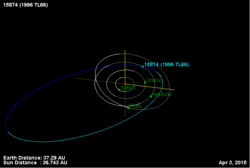Orbit and size

1996 TL66 orbits the Sun with a semi-major axis of 83.9 AU [2] but is currently only 35 AU from the Sun with an apparent magnitude of 21. [8] In 2007, the Spitzer Space Telescope estimated it to have a low albedo with a diameter of about 575±115 km. [6] More-recent measurements in 2012 by the 'TNOs are Cool' research project and reanalysis of older data have resulted in a new estimate of these figures. [5] It is now assumed that it has a higher albedo and the diameter was revised downward to 339±20 km. Light-curve-amplitude analysis shows only small deviations, suggesting 1996 TL66 has a spheroidal shape with small albedo spots. [9]